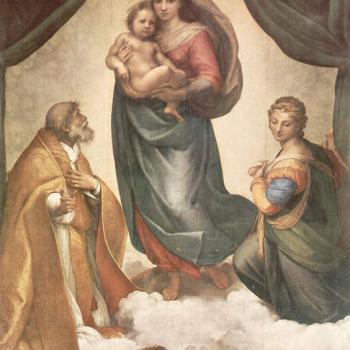Chapter 13 (pp. 383-397) of my book, Bible Truths for Catholic Truths: A Source Book for Apologists and Inquirers (Manchester, New Hampshire: Sophia Institute Press, 2009); the paperback is now out-of-print. This book could also be known as Dave’s Topical Bible, and contains 2,051 Bible passages, categorized under 115 thematic headings. I am now offering it online for free.
*
In these blog posts I use — for readers’ convenience — the original RSV of the manuscript (© 1971 by Division of Christian Education of the National Council of the Churches of Christ in the United States of America), rather than KJV, which was mostly used in the paperback, due to copyright law. This book is all Bible, except for a few (indented) clarifying comments here and there. Subtitles sometimes differ from the published version. They are my own original titles.
PERPETUAL VIRGINITY
The word brother as used in the New Testament (Greek, adelphos), has a wide range of meaning, including those of the same nationality (Rom 9:3), neighbors or any man ((Mt 5:22; 7:3; Lk 10:29), mankind (Mt 25:40; Heb 2:17), Christian believers (Acts 1:15), etc.
Neither Hebrew nor Aramaic had a word for cousin. Greek did have such a word, but since ancient Israel was a Semitic culture, they still used the equivalent of brother to signify a cousin. Jesus Himself used the word in this way. He described the “crowds” and His “disciples” as His “brethren” (Matthew 23:8; cf. 12:49-50) We see this wider usage of brother even in English today. Here are some plain examples of the wider (non-sibling) usage of adelphos:
Acts 3:12, 17, 22 And when Peter saw it he addressed the people, “Men of Israel, . . . And now, brethren, I know that you acted in ignorance, as did also your rulers. . . . Moses said, ‘The Lord God will raise up for you a prophet from your brethren as he raised me up. . . . ‘”
Acts 7:23-27 When he was forty years old, it came into his heart to visit his brethren, the sons of Israel. And seeing one of them being wronged, he defended the oppressed man and avenged him by striking the Egyptian. He supposed that his brethren understood that God was giving them deliverance by his hand, but they did not understand. And on the following day he appeared to them as they were quarreling and would have reconciled them, saying, “Men, you are brethren, why do you wrong each other?” But the man who was wronging his neighbor thrust him aside, saying, “Who made you a ruler and a judge over us?”
Romans 1:7, 13 To all God’s beloved in Rome, who are called to be saints: . . . I want you to know, brethren, . . .
I Thessalonians 1:1, 4 Paul, Silva’nus, and Timothy, To the church of the Thessalo’nians . . . For we know, brethren beloved by God, that he has chosen you;
Hebrews 7:5 And those descendants of Levi who receive the priestly office have a commandment in the law to take tithes from the people, that is, from their brethren, though these also are descended from Abraham.
Revelation 22:9 . . . your brethren the prophets, . . .
St. Paul uses adelphos some 138 times, and it seems clear that in virtually every case, the meaning is in the wider “non-sibling” sense. Thus, when he refers to “James the Lord’s brother” in Galatians 1:19, it is altogether sensible to interpret it in the same way. Keeping this usage in mind, let’s look specifically at several related passages that mention Jesus’ “brothers”:
Matthew 13:55-56 Is not this the carpenter’s son? Is not his mother called Mary? And are not his brothers James and Joseph and Simon and Judas? And are not all his sisters with us? Where then did this man get all this?
Matthew 27:56 among whom were Mary Mag’dalene, and Mary the mother of James and Joseph, and the mother of the sons of Zeb’edee.
Matthew 27:61 Mary Mag’dalene and the other Mary were there, sitting opposite the sepulchre.
Matthew 28:1 Now after the sabbath, toward the dawn of the first day of the week, Mary Mag’dalene and the other Mary went to see the sepulchre.
Mark 6:3 Is not this the carpenter, the son of Mary and brother of James and Joses and Judas and Simon, and are not his sisters here with us?” And they took offense at him.
Mark 15:40 There were also women looking on from afar, among whom were Mary Mag’dalene, and Mary the mother of James the younger and of Joses, and Salo’me,
John 19:25 So the soldiers did this. But standing by the cross of Jesus were his mother, and his mother’s sister, Mary the wife of Clopas, and Mary Mag’dalene.
James and Joseph, who are described as Jesus’ “brothers” (Mt 13:55; Mk 6:3), are also called sons of Mary, wife of Clopas (Mt 27:56; Mk 15:40; cf. Jn 19:25). Thus, they were either Jesus’ cousins or fellow Israelites; not literally siblings. This same “other Mary” (Mt 27:61; 28:1) is called the Blessed Virgin Mary’s “sister” (adelphe) in John 19:25.
Since it is unlikely that there were two Marys in one family, again the text must be referring to the Virgin Mary’s cousin or more distant relative. By quite plausible deduction, then, Simon, Jude, and “sisters” (Mt 13:55-56; Mk 6:3) are also Jesus’ cousins or more remote relatives.
We may have a bit more biblical information about the “brother” Judas. Many scholars believe he could very well be the same person as the “Jude” who wrote the New Testament book of the same name. Granting this for the sake of argument, note that he describes himself as “a servant of Jesus Christ and brother of James” (1:1). It strains credulity to think that if he were Jesus’ blood brother, or sibling, that he would describe himself as James’ brother. Therefore, it is far more reasonable to believe that he is James’ sibling and Jesus’ cousin or more distant relative; just as we have seen is the case with James himself, from direct exegetical indications.
Other arguments for Jesus being Mary’s only child derive from He alone being mentioned at age twelve, visiting the Temple with His parents for the yearly Passover observance (Luke 2:41-51), and His committing His mother Mary to the care of St. John, from the cross (John 19:26-27). It was unthinkable in that culture (as in most cultures) to do that if indeed Jesus had siblings.
Lastly, some think it is telling that sungenis (Greek for cousin) isn’t used in direct reference to Jesus “brothers.” Apart from the cultural considerations already discussed, there is at least one plausible indirect argument from cross-referencing, where this association does occur:
Mark 6:4 And Jesus said to them, “A prophet is not without honor, except in his own country, and among his own kin [sungenis], and in his own house.”
John 7:3-5 So his brothers said to him, “Leave here and go to Judea, that your disciples may see the works you are doing. For no man works in secret if he seeks to be known openly. If you do these things, show yourself to the world.” For even his brothers did not believe in him.
The two passages seem to be describing the same thing. If so, then this would be an equation of those who are called “brothers” in John 5, with “kin” (sungenis) in Mark 6:4; thus confirming the traditional Catholic interpretation yet again: that these “brothers” and “sisters” of Jesus are not siblings. Therefore, the doctrine of Mary’s perpetual virginity is perfectly consistent with all of the biblical data, closely examined (which is why Luther, Calvin, and many Protestants through history have accepted this truth alongside Catholics and Orthodox).
IMMACULATE CONCEPTION
Luke 1:26-28 In the sixth month the angel Gabriel was sent from God to a city of Galilee named Nazareth, to a virgin betrothed to a man whose name was Joseph, of the house of David; and the virgin’s name was Mary. And he came to her and said, “Hail, full of grace [non-Catholic RSV edition: “O favored one”], the Lord is with you!”
The Greek word for “full of grace” or “favored one” is kecharitomene: perfect passive participle of charitoo, which means “endowed with grace.” Charis (the Greek word for grace) is translated in the KJV, as “grace” 129 times out of about 150 appearances. This passage teaches the sinlessness of Mary — itself the root assumption of the developed doctrine of the Immaculate Conception. With additional cross-referencing of a lot of scriptural material concerning grace, the striking “Catholic” conclusion becomes a lot clearer than it is at first glance.
For St. Paul, grace (charis) is the antithesis and overcomer of sin:
Romans 5:17, 20-21 If, because of one man’s trespass, death reigned through that one man, much more will those who receive the abundance of grace and the free gift of righteousness reign in life through the one man Jesus Christ. . . . Law came in, to increase the trespass; but where sin increased, grace abounded all the more, so that, as sin reigned in death, grace also might reign through righteousness to eternal life through Jesus Christ our Lord.
Romans 6:14 For sin will have no dominion over you, since you are not under law but under grace. (cf. similar “zero-sum game” notions in 1 John 1:7, 9; 3:6, 9; 5:18)
2 Corinthians 1:12 For our boast is this, the testimony of our conscience that we have behaved in the world, and still more toward you, with holiness and godly sincerity, not by earthly wisdom but by the grace of God.
2 Corinthians 12:9 but he said to me, “My grace is sufficient for you, for my power is made perfect in weakness.” I will all the more gladly boast of my weaknesses, that the power of Christ may rest upon me.
2 Timothy 1:9 who saved us and called us with a holy calling, not in virtue of our works but in virtue of his own purpose and the grace which he gave us in Christ Jesus ages ago,
We are saved, of course, by grace, and grace alone:
Acts 15:11 But we believe that we shall be saved through the grace of the Lord Jesus, just as they will.
Romans 3:24 they are justified by his grace as a gift, through the redemption which is in Christ Jesus, (cf. 11:5)
Ephesians 2:5 . . . (by grace you have been saved),
Ephesians 2:8-9 For by grace you have been saved through faith; and this is not your own doing, it is the gift of God– not because of works, lest any man should boast.
Titus 2:11 For the grace of God has appeared for the salvation of all men,
Titus 3:7 so that we might be justified by his grace and become heirs in hope of eternal life. (cf. 1 Pet 1:10)
The implications of all this for Luke 1:28 and the Immaculate Conception of Mary now start to become more apparent. From the above data we learn that two things are biblically certain:
1) Grace saves us.
2) Grace gives us the power to be holy and righteous and without sin.
Therefore, for a person to be full of grace is to both be saved and to be exceptionally, completely holy. The Bible also teaches that people can have different levels of grace (Acts 4:33; Rom 5:20; 6:1; Eph 4:7; Jas 4:6; 1 Pet 5:5; 2 Pet 1:2; 3:18). And Mary, as we know from Luke 1:28, was “full of grace.” Thus, we can restate the above two propositions with Mary in mind, as follows:
1) To be full of the grace which saves is to surely be saved.
2) To be full of the grace which gives us the power to be holy and righteous and without sin, is to be fully without sin, by that same grace.
Or, we could make the following deductive argument, with premises (#1 and #2) derived directly from Scripture:
1) The Bible teaches that we are saved by God’s grace.
2) The Bible teaches that we need God’s grace to live a holy life, above sin.
3) To be “full of” God’s grace, then, is to be saved.
4) Therefore, Mary is saved.
5) To be “full of” God’s grace is also to be so holy that one is sinless.
6) Therefore, Mary is holy and sinless.
7) The essence of the Immaculate Conception is sinlessness.
8) Therefore, the Immaculate Conception, in its essence, is directly deduced from the strong evidence of many biblical passages, which teach the doctrines of #1 and #2.
The logic follows inexorably from unquestionable biblical principles. The only way out of it would be to deny one of the two premises, and hold that either (1) grace doesn’t save, or that (2) grace isn’t that power which enables one to be sinless and holy. In this fashion, the entire essence of the Immaculate Conception is proven from explicit biblical statements, and principles and doctrines that every orthodox Protestant holds. All of this follows straightforwardly from Luke 1:28 and the (primarily Pauline) exegesis of charis elsewhere in the New Testament.
Luke 1:35 And the angel said to her, “The Holy Spirit will come upon you, and the power of the Most High will overshadow you; therefore the child to be born will be called holy, the Son of God.”
The Greek word for overshadow is episkiasei, which describes a bright, glorious cloud. It is used with reference to the cloud of transfiguration of Jesus (Mt 17:5; Mk 9:7; Lk 9:34) and also has a connection to the shekinah glory of God in the Old Testament (Ex 24:15-16; 40:34-38; 1 Ki 8:10). Mary is, therefore, in effect, the new temple and holy of holies, where God was present in a special fashion. In fact, Scripture draws many parallels between Mary, the “ark of the new covenant” and the ark of the (old) covenant:
Exodus 40:34-35 Then the cloud covered the tent of meeting, and the glory of the LORD filled the tabernacle. And Moses was not able to enter the tent of meeting, because the cloud abode upon it, and the glory of the LORD filled the tabernacle.
The Greek Septuagint translation uses the same word, episkiasei, in this passage.
1 Kings 8:6-11 Then the priests brought the ark of the covenant of the LORD to its place, in the inner sanctuary of the house, in the most holy place, underneath the wings of the cherubim. For the cherubim spread out their wings over the place of the ark, so that the cherubim made a covering above the ark and its poles. And the poles were so long that the ends of the poles were seen from the holy place before the inner sanctuary; but they could not be seen from outside; and they are there to this day. There was nothing in the ark except the two tables of stone which Moses put there at Horeb, where the LORD made a covenant with the people of Israel, when they came out of the land of Egypt. And when the priests came out of the holy place, a cloud filled the house of the LORD, so that the priests could not stand to minister because of the cloud; for the glory of the LORD filled the house of the LORD.
More direct parallels occur as well:
2 Samuel 6:9 And David was afraid of the LORD that day; and he said, “How can the ark of the LORD come to me?”
Luke 1:43 And why is this granted me, that the mother of my Lord should come to me?
2 Samuel 6:15 So David and all the house of Israel brought up the ark of the LORD with shouting, and with the sound of the horn.
Luke 1:42 and she exclaimed with a loud cry, “Blessed are you among women, and blessed is the fruit of your womb!”
2 Samuel 6:14, 16 And David danced before the LORD with all his might; and David was girded with a linen ephod. . . . King David leaping and dancing before the LORD . . .
1 Chronicles 15:29 And as the ark of the covenant of the LORD came to the city of David, Michal the daughter of Saul looked out of the window, and saw King David dancing and making merry . . .
Luke 1:44 For behold, when the voice of your greeting came to my ears, the babe in my womb leaped for joy.
2 Samuel 6:10-11 So David was not willing to take the ark of the LORD into the city of David; but David took it aside to the house of O’bed-e’dom the Gittite. And the ark of the LORD remained in the house of O’bed-e’dom the Gittite three months . . .
Luke 1:39, 56 In those days Mary arose and went with haste into the hill country, to a city of Judah, . . . And Mary remained with her about three months, and returned to her home.
Further reflection on “holy places” and “holy items” (see Chapter Two) brings out the meaning of the striking parallel symbolism. The Temple and Tabernacle were holy, and this was especially the case with the holy of holies, where the ark was kept. God was said to dwell above the ark, between the two cherubim (Ex 25:22). The presence of God always imparted holiness (Duet 7:6; 26:19; Jer 2:3). The furnishings of the Tabernacle could not be touched by anyone, save a few priests, on pain of death (Num 1:51-53; 2:17; 4:15).
This was true of the holiest things, associated with God and worship of God. The high priest only entered the holy of holies once a year, on the Day of Atonement (Num 29:8). The Jews would tie a rope to his leg in case he perished from improper behavior (Lev 16:2, 13), so they could pull him out. This was true of the ark itself. Uzziah merely reached out to steady it when it was toppling over, and was struck dead (2 Samuel 6:2-7). Others died when they simply looked inside of it (1 Sam 6:19; cf. Ex 33:20).
This is how God regards people and even inanimate objects that are in close proximity to Him. Thus, Mary, as the ark of the new covenant, Theotokos (“bearer of God”): the one who had the sublime honor of carrying God incarnate in her womb, had to be exceptionally holy to do so. This is indicated by both Luke 1:28: understood in its full implications, and the ark parallels noted above. Thus, her sinlessness is strongly indicated, and this is the premise of her Immaculate Conception, meaning that God miraculously preserved her free from the stain of original sin, from the moment of her conception. It was a free act of grace, obviously having nothing to do with Mary’s will. Hence, “full of grace” and all its implications.
It’s not as if being without sin is completely unimaginable. Adam and Eve were originally created without sin. The angels also were, and the ones who did not rebel have never sinned. There will eventually be no sin in heaven, when all things are redeemed. Prophets were exceptionally holy, and some (like Jeremiah and John the Baptist) were even sanctified from the womb, as Mary was:
Jeremiah 1:5 Before I formed you in the womb I knew you, and before you were born I consecrated you; I appointed you a prophet to the nations. (cf. Is 49:1, 5)
Sirach 49:7 . . . he had been consecrated in the womb as prophet, . . .
Luke 1:15 . . . he will be filled with the Holy Spirit, even from his mother’s womb.
The Immaculate Conception and Mary’s sinlessness are, therefore, concepts that are perfectly harmonious with what was taught in the Bible from the beginning, and even some explicit scriptural proofs on their behalf exist, as shown above.
ASSUMPTION
No direct biblical indications of Mary’s assumption are to be found. But (as always with Catholic doctrine), there are indirect, deductive arguments from things that are clear in Scripture, and nothing in Scripture that would contradict the possibility of this happening. There were, for example, several “bodily going to heaven” events recorded in Scripture that bear some similarity to the Catholic belief in Mary’s bodily assumption:
Genesis 5:24 Enoch walked with God; and he was not, for God took him.
2 Kings 2:1, 11 Now when the LORD was about to take Eli’jah up to heaven by a whirlwind, Eli’jah and Eli’sha were on their way from Gilgal. . . . And as they still went on and talked, behold, a chariot of fire and horses of fire separated the two of them. And Eli’jah went up by a whirlwind into heaven.
Acts 1:9 And when he had said this, as they were looking on, he was lifted up, and a cloud took him out of their sight.
2 Corinthians 12:2-3 I know a man in Christ who fourteen years ago was caught up to the third heaven — whether in the body or out of the body I do not know, God knows. And I know that this man was caught up into Paradise — whether in the body or out of the body I do not know, God knows –
1 Thessalonians 4:15-17 For this we declare to you by the word of the Lord, that we who are alive, who are left until the coming of the Lord, shall not precede those who have fallen asleep. For the Lord himself will descend from heaven with a cry of command, with the archangel’s call, and with the sound of the trumpet of God. And the dead in Christ will rise first; then we who are alive, who are left, shall be caught up together with them in the clouds to meet the Lord in the air; and so we shall always be with the Lord.
Hebrews 11:5 By faith Enoch was taken up so that he should not see death; and he was not found, because God had taken him. Now before he was taken he was attested as having pleased God.
Revelation 11:9-12 For three days and a half men from the peoples and tribes and tongues and nations gaze at their dead bodies and refuse to let them be placed in a tomb, and those who dwell on the earth will rejoice over them and make merry and exchange presents, because these two prophets had been a torment to those who dwell on the earth. But after the three and a half days a breath of life from God entered them, and they stood up on their feet, and great fear fell on those who saw them. Then they heard a loud voice from heaven saying to them, “Come up hither!” And in the sight of their foes they went up to heaven in a cloud.
If one accepts Mary’s Immaculate Conception, the Assumption follows from the fact of absence of sin. Bodily death and decay, after all, come about as a result of sin and the fall:
Genesis 3:14 ,19 The LORD God said to the serpent, “Because you have done this, cursed are you above all cattle, and above all wild animals; upon your belly you shall go, and dust you shall eat all the days of your life. . . . In the sweat of your face you shall eat bread till you return to the ground, for out of it you were taken; you are dust, and to dust you shall return.” (cf. Ps 16:10)
Romans 5:12, 17 Therefore as sin came into the world through one man and death through sin, and so death spread to all men because all men sinned — . . . because of one man’s trespass, death reigned . . .
The Blessed Virgin Mary was the “first fruits” (after Jesus) of what will eventually be a general resurrection:
1 Corinthians 15:12-26 Now if Christ is preached as raised from the dead, how can some of you say that there is no resurrection of the dead? But if there is no resurrection of the dead, then Christ has not been raised; if Christ has not been raised, then our preaching is in vain and your faith is in vain. We are even found to be misrepresenting God, because we testified of God that he raised Christ, whom he did not raise if it is true that the dead are not raised. For if the dead are not raised, then Christ has not been raised. If Christ has not been raised, your faith is futile and you are still in your sins. Then those also who have fallen asleep in Christ have perished. If for this life only we have hoped in Christ, we are of all men most to be pitied. But in fact Christ has been raised from the dead, the first fruits of those who have fallen asleep. For as by a man came death, by a man has come also the resurrection of the dead. For as in Adam all die, so also in Christ shall all be made alive. But each in his own order: Christ the first fruits, then at his coming those who belong to Christ. Then comes the end, when he delivers the kingdom to God the Father after destroying every rule and every authority and power. For he must reign until he has put all his enemies under his feet. The last enemy to be destroyed is death. (cf. Mt 27:52-53)
Mary was preserved from sin in order to bear God incarnate. Because of this, she didn’t have to undergo the bodily decay that is the lot of all fallen human beings. What more appropriate person should be made the “Second Eve”: like Eve was before the fall? It makes perfect sense. The Assumption goes hand in hand with the General Resurrection and the Immaculate Conception, and the latter goes hand-in-hand with the Incarnation itself. In biblical thinking, all things have a relationship to each other. Thus we see her being greatly exalted and venerated in heaven:
Revelation 12:1-5 And a great portent appeared in heaven, a woman clothed with the sun, with the moon under her feet, and on her head a crown of twelve stars; she was with child and she cried out in her pangs of birth, in anguish for delivery. And another portent appeared in heaven; behold, a great red dragon, with seven heads and ten horns, and seven diadems upon his heads. His tail swept down a third of the stars of heaven, and cast them to the earth. And the dragon stood before the woman who was about to bear a child, that he might devour her child when she brought it forth; she brought forth a male child, one who is to rule all the nations with a rod of iron, but her child was caught up to God and to his throne,
*****
*
Photo Credit: Benois Madonna (c. 1480), by Leonardo da Vinci (1452-1519) [public domain / Wikimedia Commons]
***
Summary: Ch. 13 of my book, Bible Truths for Catholic Truths: A Source Book for Apologists and Inquirers (Manchester, New Hampshire: Sophia Institute Press, 2009).














